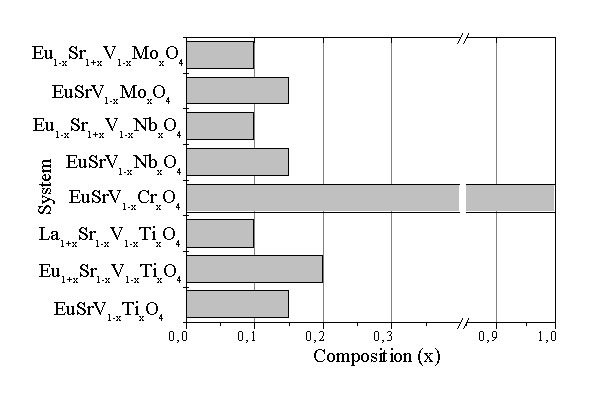
SOLID SOLUTIONS IN THE Ln-Sr-V-M-O (Ln=La, Eu; M=Ti, Cr, Mo,Nb) SYSTEMS WITH THE K2NiF4-TYPE STUCTURE
S.A. Nedilko, V.A. Drozd
Chemistry Deaprtment, Kiev Taras Shevchenko University, Ukraine (drozd@nsa.chem.univ.kiev.ua)
Vanadium(III) oxide compounds with strontium and rare-earth metals LnSrVO4 having tetragonal structure of K2NiF4 [1] are structural and electronic analogue of Ln2CuO4- superconducting cuprates. The attempts to turn LnSrVO4 into metallic and then superconducting state by heterovalent substitution according to the scheme Ln3+ + V3+ ->Sr2+ + V4+ failed [2].
In present abstract we report some details of the transition metals substitution for vanadium in LnSrVO4 (Ln = La, Eu) and effects of such substitution on crystal structure and electrical properties of the compounds studied.
The samples of LnSrV1-xMxO4, Ln1-xSr1+xV1-xMxO4 and Ln1+xSr1-xV1-xMxO4 with Ln = La, Eu and M = Ti, Cr, Nb, Mo) were synthesized through a solid state reaction route with ingredients of Ln2O3, Sr(NO3)2, V2O5, TiO2, Cr(OH)3 xH2O, Nb2O5 and MoO3. Mixtures containing appropriate ratios of starting materials were fired in an Al2O3 crusible at 600oC for 2 h in air and then at 850 - 900oC for 15 - 24 h. After thorough grinding in an agate mortar, the powders obtained were pressed into pellets, placed in a molybdenum crucible, and then annealed in flowing purified H2 at 1200 - 1250oC for 15 h, with intermediate regounding followed by pelletisation after 7 h of reduction.
Compounds obtained were studied by X-ray powder diffraction, DTA/DTG and resistivity measurements.
A continuous range (0 <= x <= 1.0) of solid solutions has been found in the EuSrV1-xCrxO4 system, while all the other systems studied showed limited solubility of transition metals (see fig.). Tetragonal structure of K2NiF4-type was observed for all compounds studied. Vegrd's law was found to describe the tetragonal lattice parameters evolution in the solid solutions EuSrV1xCrxO4.
Single-phase regions of the solid solutions studied.
Single-phase region in the EuSrV1-xTixO4 system were found to be smaller than that in the Eu1+xSr1-xV1-xTixO4 system. We can assume that in the latter system the Eu2+ - Ti4+ valent pair exists concurrently with the Eu3+ - V3+ combination, while the first system contains Ti3+ and V3+ ions only. In addition, we have synthesized several samples using La instead of Eu that is Eu1+xSr1-xV1-xTixO4 and obtained materials with rather limited (x < 0.1) solubility of Ti. But, of course, some more investigations are needed to solve this problem.
The measurements of the resistivity temperature dependence have revealed the semiconducting behaviour of all the samples. It was found that transition metals (except M = Mo) substitution for vanadium caused an increase of the resistivity. Only in the case of M = Mo a slight increase in the conductivity was observed for both EuSrV1-xMoxO4 and Eu1-xSr1+xV1-xMoxO4 systems
